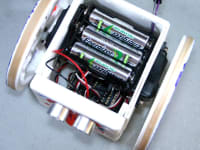my RoboGuts™ Kits S.T.E.A.M. educational program; http://www.r2pv1.com/PICAXE28X2m/
Starting with the RoboGuts™ circuit board the students learn to add a few jumper wires to complete a real circuit. Then add the programming the student is learning structured programming using BASIC language so they learn about writing library functions as well. Then add the speech and singing using phonemes so their project can speak and sing songs in any language. Then after they've 3D printed the plastic parts while they worked on the first electronics and programming lessons for a project and learn to do the finishing which includes trimming off excess and painting features before assembly starts.
By the time they've completed their first project, the student will have gone through most of the manufacturing process. The next step is to teach them 3D CAD modeling so they can begin to design their own projects and build more.
What they learn in electronics is jumper wiring, standard hobby 3-wire connections, resistor color codes, common anode/cathode as well as ground and V+ concepts, how to connect various sensors, LEDs, motors and othe peripheral electronic components.
What they learn in programming is how to build libraries for common use in structured programming style which makes them better programmers using BASIC language or c language or other languages chosen by the instructor based on the chip or module selected for the classes.
What they learn with teaching their project to speak and sing using phonemes is how phonemes work, timing of speech and song as well as musical note relationships in songs.
The student will learn about 3D printing to print the plastic parts they need for their end lesson projects as well as finishing/polishing the parts and fitting the parts together readying the plastic parts for painting to create the added features of the final product they make themselves.
What they learn with assembly is how to glue 'n screw hobby components onto the plastic parts for assembling wheels and other appendages for their project. How simple snap together components work as well as using screws, bolts and rivets.
The final lesson is that they have made their own toy that they now know how to reprogram for other performances or functions and have gone through nearly the entire manufacturing process which they can explore with further lessons in the schools … or L'Robotorium shops.
Video
Like this entry?
-
About the Entrant
- Name:Walt Perko
- Type of entry:individual
- Software used for this entry:SolidWorks, PICAXE, Prgm Editor, Phrase-A-Lator
- Patent status:none








